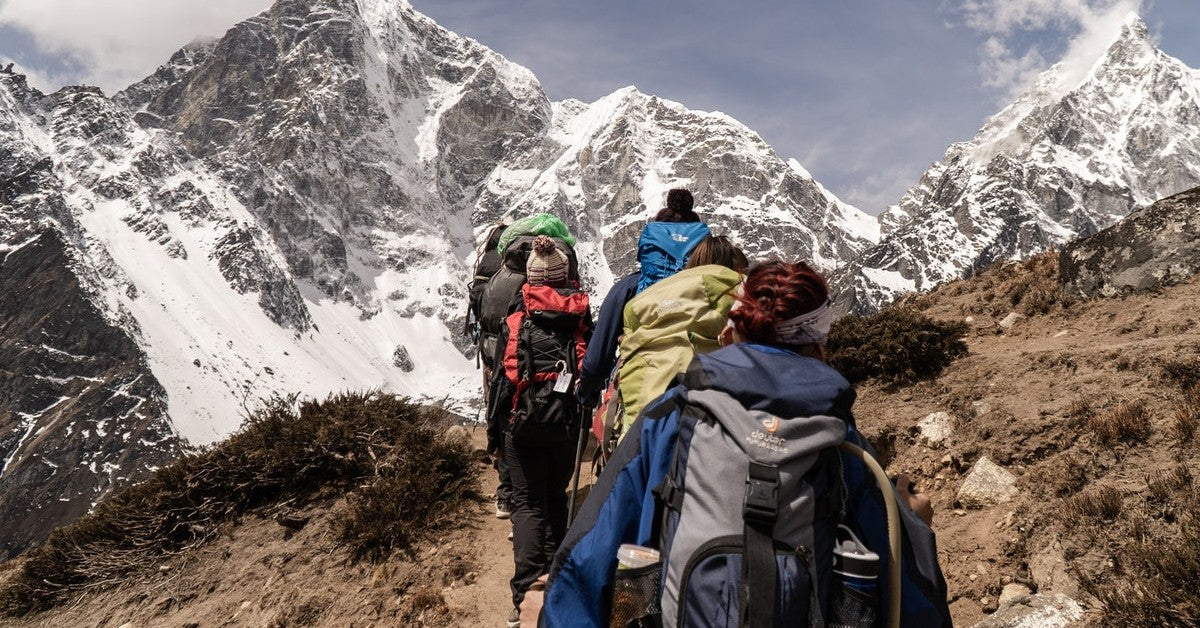
How to Climb Mountains with TSA-Compliant Klik Belts
A popular saying is to climb a mountain you have to take the first step. While this is usually used metaphorically to describe how to accomplish a goal, it has some truth to it when you are mountain climbing. You do have to take the first step; however, there is much more involved than that — and much more needed. While day hikes into the mountains don’t require too much mountain climbing gear, some pieces of equipment are still essential — such as your TSA-compliant belt by Klik Belts. In this blog post, we’ll go over some tips to begin mountain climbing, including some basic fundamental gear you will need. Browse our online belts that are TSA-compliant today!
TIPS TO CLIMB MOUNTAINS
Research, Research, Research
Climbing mountains is not for the faint of heart, and it is just as much about being mentally fit as it is about being physically fit. A good way to learn about what you are getting into is to read accounts of other mountaineers. Klik Belts, a company that makes top-notch TSA-compliant belts, notes that there are many good books of climbing adventures, as well as movies and documentaries you can watch.
Besides learning about climbing itself, you’ll need to learn about your particular mountain you are considering climbing. Mountains are like people — each unique in their own special way with different climbing challenges and different weather patterns, depending on where they are located at on the globe. For example, if you want to climb in Europe, it’s best to go to June to September. For Alaska, the ideal climbing time is June and July.
Weather is a big part of climbing as well, and on mountain ranges, weather can turn at the drop of a hat. There are generalities to learn about particular mountain ranges, but like Klik Belts mentioned above, each mountain will have its own unique weather patterns you must learn. This is a very important piece to climbing mountains and the more of an amateur meteorologist you become, the better prepared you will be. From learning to read the clouds and what bad weather looks like to knowing about lighting, mountain weather will be crucial in your mountain climbing edification.
Suffice it to say, climbing mountains will be a lot of work, but well worth it in the end when you conquer your first summit!
Get in Shape
Deciding to climb mountains is not like deciding to read 100 books in a year. You have to be physically prepared, as well as mentally prepared. If you are out of shape and don’t have the stamina or endurance built up, then you will not be an able-bodied mountain climber. You could also be putting your friends at risk who would have to carry you down the mountain if at some point you can’t continue. You will need a dedicated fitness regime in order to build the strength and endurance you will need to climb mountains. Activities such as running, weightlifting, climbing practice at indoor climbing places, and skiing and snowboarding should all be incorporated into your routine. Deciding to climb mountains is a decision that should not be taken lightly, and physical preparation is a must.
Join a Club
It’s important before you venture forth on your first mountaineering adventure to find a mentor. By joining a club, you’ll not only meet local mountaineers who are usually willing to take you along on climbs, but you’ll also find those just like yourself — beginners interested in the sport. There are many dangers when you climb mountains, and one of the first rules you’ll learn is to never climb alone. Klik Belts, a maker of the best TSA-compliant belts notes that you’ll need help if something happens, and finding climbing buddies is one of the preliminary steps to climbing mountains.
Learn About Pushing the Limits
Climbing mountains can be extremely physically taxing as well as mentally taxing. However, the ability to make good decisions under duress can mean the difference between life and death. In fact, for many mountain climbers, part of the allure is the mental aspect. You’ll need to be sure you can push past mental barriers when your body has had enough. You’ll need to be a good problem-solver, as well as have a positive attitude. Overabundance of self-confidence, however, can spell trouble.
Gear Up
Klik Belts, a proprietor of the best TSA-compliant belts, notes that mountain climbing gear will be essential to your success. While mountain climbing gear can be expensive, this is something you can slowly invest in over time. Like all things, the better the quality, the better your experience will be, so going for the cheapest option may not be for you. Some of the essential mountain climbing gear you will need include:
- High-quality backpack, which is one of the most important pieces of a mountain climber’s gear
- Helmet
- Ice axe or hammer
- Head lamp
- Warm clothing designed for extreme weather
- Top-notch climbing boots with crampons
- Harness or belay break
- Tent
- Sleeping bag that can withstand low temperatures
- Pocket knife
- TSA-compliant belt
- And much more!
Klik Belts includes our TSA-compliant belt on the mountain climber’s must-have list for several reasons. These TSA-compliant belts are meant to do their job — hold your pants up. They are airport-friendly belts, meaning if you are climbing mountains outside of your native country, you’ll need to get through airport security quickly. Our heavy duty and our tactical TSA-compliant belts, such as our 1.5" Black Poly/Coyote Brown 2-Ply TSA-Approved Belt are built to hold up under the toughest wear, including mountains.
MOUNTAIN CLIMBING & SURVIVING WITH TSA-COMPLIANT BELTS
As one of the best companies that makes TSA-compliant belts, Klik Belts has also designed our rugged, heavy duty belts to be the best in the business. This means that in a survival situation, a camping, heavy duty belt can do a lot of things in a pinch. For instance, our TSA-compliant belts can carry survival gear, such as flashlights and hatchets. You can use your airport-friendly belt to make cordage. You can use your heavy duty belt to hang food off the ground with. Of course, your travel belt can be used as a tourniquet, a sling, or a splint if need be. There are so many uses for your TSA-compliant belt that having one is not only a time saver but an essential part of your mountain climbing gear. When you can breeze through airport security without having to take your airport-friendly belt off, you’ll be that much closer to the summit of your first mountain. Browse our spectacular selection, and order today!








